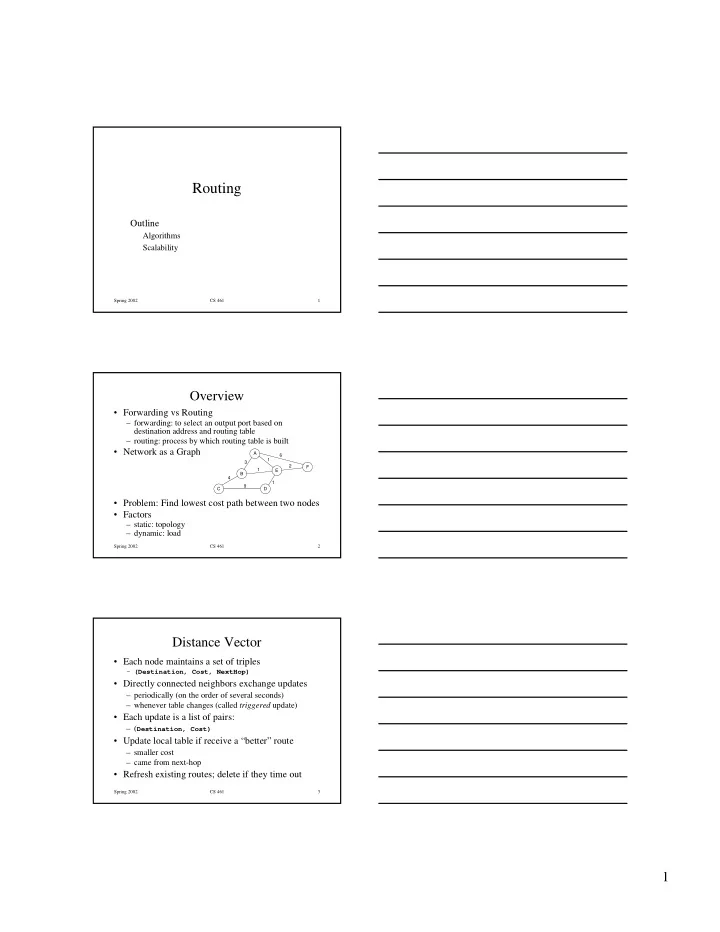

Routing Outline Algorithms Scalability Spring�2002 CS�461 1 Overview • Forwarding�vs Routing – forwarding:�to�select�an�output�port�based�on� destination�address�and�routing�table – routing:�process�by�which�routing�table�is�built • Network�as�a�Graph A 6 1 3 2 F 1 E B 4 1 9 C D • Problem:�Find�lowest�cost�path�between�two�nodes • Factors – static:�topology – dynamic:�load Spring�2002 CS�461 2 Distance�Vector • Each�node�maintains�a�set�of�triples� – (Destination,�Cost,�NextHop) • Directly�connected�neighbors�exchange�updates – periodically�(on�the�order�of�several�seconds) – whenever�table�changes�(called� triggered update) • Each�update�is�a�list�of�pairs: – ( Destination,�Cost) • Update�local�table�if�receive�a�“better”�route – smaller�cost – came�from�next-hop • Refresh�existing�routes;�delete�if�they�time�out Spring�2002 CS�461 3 1
Example B Destination���Cost�� NextHop C A A 1 A D C 1 C D 2 C E E 2 A F 2 A F G G 3 A Spring�2002 CS�461 4 Routing�Loops • Example�1 – F�detects�that�link�to�G�has�failed – F�sets�distance�to�G�to�infinity�and�sends�update�t�o�A – A�sets�distance�to�G�to�infinity�since�it�uses�F�to�reach�G – A�receives�periodic�update�from�C�with�2-hop�path�to�G – A�sets�distance�to�G�to�3�and�sends�update�to�F – F�decides�it�can�reach�G�in�4�hops�via�A • Example�2 – link�from�A�to�E�fails – A�advertises�distance�of�infinity�to�E – B�and�C�advertise�a�distance�of�2�to�E – B�decides�it�can�reach�E�in�3�hops;�advertises�this�to�A – A�decides�it�can�read�E�in�4�hops;�advertises�this�to�C – C�decides�that�it�can�reach�E�in�5�hops… Spring�2002 CS�461 5 Loop- Breaking Heuristics • Set�infinity�to�16 • Split�horizon • Split�horizon�with�poison�reverse Spring�2002 CS�461 6 2
Link�State • Strategy – send�to�all�nodes�(not�just�neighbors)� information�about�directly�connected�links�(not� entire�routing�table) • Link�State�Packet�(LSP) – id�of�the�node�that�created�the�LSP – cost�of�link�to�each�directly�connected�neighbor – sequence�number�(SEQNO) – time-to-live�(TTL)�for�this�packet Spring�2002 CS�461 7 Link�State�(cont) • Reliable�flooding – store�most�recent�LSP�from�each�node – forward�LSP�to�all�nodes�but�one�that�sent�it – generate�new�LSP�periodically • increment��SEQNO – start�SEQNO�at�0�when�reboot – decrement�TTL�of�each�stored�LSP • discard�when�TTL=0 Spring�2002 CS�461 8 Route�Calculation • Dijkstra’s�shortest�path�algorithm • Let – N denotes�set�of�nodes�in�the�graph – l� ( i ,� j )�denotes�non-negative�cost�(weight)�for�edge�( i ,� j ) – s denotes�this�node – M denotes�the�set�of�nodes�incorporated�so�far – C ( n )�denotes�cost�of�the�path�from� s to�node� n M� =�{ s } for�each� n in� N - { s } C ( n )�=� l ( s ,� n ) while�( N !=� M ) M =� M� union�{ w }�such�that� C ( w )�is�the�minimum�for all� w in�( N�- M ) for�each� n in�( N�- M ) C ( n )�=�MIN( C ( n ),� C ( w )�+� l ( w,�n� )) Spring�2002 CS�461 9 3
Metrics� • Original�ARPANET�metric – measures�number�of�packets�queued�on�each�link – took neither�latency�or�bandwidth�into�consideration • New�ARPANET�metric – stamp�each�incoming�packet�with�its�arrival�time�( AT ) – record�departure�time�( DT ) – when�link-level�ACK�arrives,�compute Delay�=�(DT�- AT)�+�Transmit�+�Latency – if�timeout,�reset� DT to�departure�time�for�retransmission� – link�cost�=�average�delay�over�some�time�period • Fine�Tuning – compressed�dynamic�range – replaced� Delay with�link�utilization� Spring�2002 CS�461 10 How�to�Make�Routing�Scale • Flat�versus�Hierarchical�Addresses • Inefficient�use�of�Hierarchical�Address�Space – class�C�with�2�hosts�(2/255�=�0.78%�efficient) – class�B�with�256�hosts�(256/65535�=�0.39%�efficient) • Still�Too�Many�Networks – routing�tables�do�not�scale – route�propagation�protocols�do�not�scale Spring�2002 CS�461 11 Internet�Structure Recent�Past NSFNET�backbone Stanford ISU BARRNET MidNet … regional Westnet regional regional Berkeley P ARC UNL KU UNM NCAR UA Spring�2002 CS�461 12 4
Internet�Structure Today Large�corporation “Consumer ”ISP Peering point Backbone�service�provider Peering point “ Consumer”ISP “Consumer”ISP Large�corporation Small corporation Spring�2002 CS�461 13 Subnetting • Add�another�level�to�address/routing�hierarchy:� subnet • Subnet�masks� define�variable�partition�of�host�part • Subnets�visible�only�within�site Network�number Host�number Class�B�address 111111111111111111111111 00000000 Subnet�mask�(255.255.255.0) Network�number Subnet�ID Host�ID Subnetted�address Spring�2002 CS�461 14 Subnet�Example Subnet�mask:�255.255.255.128 Subnet�number:�128.96.34.0 128.96.34.15 128.96.34.1 H1 R1 Subnet�mask:�255.255.255.128 128.96.34.130 Subnet�number:�128.96.34.128 128.96.34.139 128.96.34.129 H2 R2 H3 128.96.33.1 Forwarding�table�at�router�R1 128.96.33.14 Subnet�Number��Subnet�Mask��������Next�Hop Subnet�mask:�255.255.255.0 128.96.34.0��������255.255.255.128��interface�0 Subnet�number:�128.96.33.0 128.96.34.128����255.255.255.128��interface�1 128.96.33.0��������255.255.255.0������R2 Spring�2002 CS�461 15 5
Forwarding�Algorithm D�=�destination�IP�address for�each�entry�(SubnetNum,�SubnetMask,�NextHop) D1�=�SubnetMask�&�D if�D1�=�SubnetNum if�NextHop�is�an�interface deliver�datagram�directly�to�D else deliver�datagram�to�NextHop • Use�a�default�router�if�nothing�matches • Not�necessary�for�all�1s�in�subnet�mask�to�be�contiguous� • Can�put�multiple�subnets�on�one�physical�network • Subnets�not�visible�from�the�rest�of�the�Internet Spring�2002 CS�461 16 Supernetting� • Assign�block�of�contiguous�network�numbers�to� nearby�networks • Called�CIDR:�Classless�Inter-Domain�Routing • Represent�blocks�with�a�single�pair (first_network_address,�count) • Restrict�block�sizes�to�powers�of�2 • Use�a�bit�mask�(CIDR�mask)�to�identify�block�size • All�routers�must�understand�CIDR�addressing Spring�2002 CS�461 17 Route�Propagation • Know�a�smarter�router – hosts�know�local�router – local�routers�know�site�routers – site�routers�know�core�router – core�routers�know�everything • Autonomous�System�(AS) – corresponds�to�an�administrative�domain – examples:�University,�company,�backbone�network – assign�each�AS�a�16-bit�number • Two-level�route�propagation�hierarchy – interior�gateway�protocol�(each�AS�selects�its�own) – exterior�gateway�protocol�(Internet-wide�standard) Spring�2002 CS�461 18 6
Recommend
More recommend